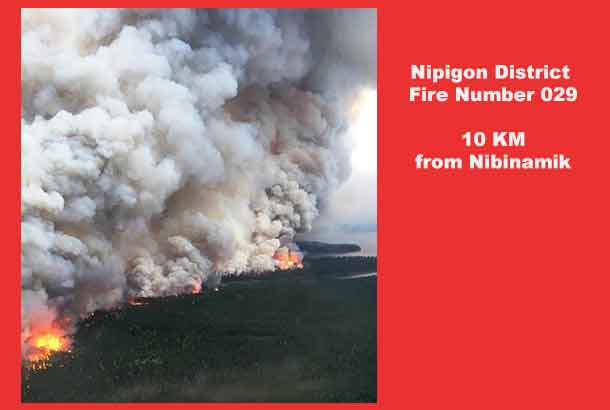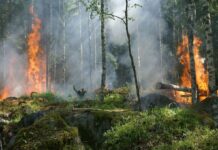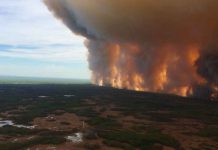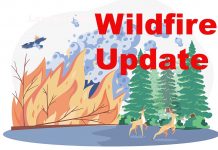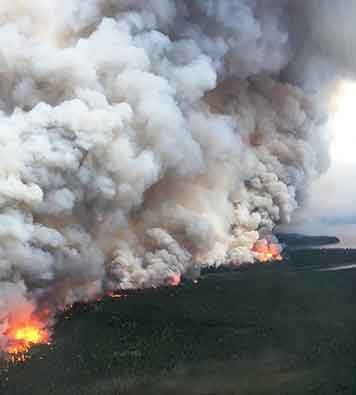
150 Active Fires in Northwestern Ontario
THUNDER BAY – There were 10 confirmed new fires by the afternoon of August 15 in the Northwest Region and 13 new fires confirmed by day’s end on August 14. There are 150 active fires in the NWR in various states of suppression as of August 15th.
One fire of note, Nipigon District Fire Number 099 is a lightning-caused fire that started on August 12 northeast of Nipigon in the Kama Hill area. Immediate response was done on the fire with a helitack crew from Greenstone Fire Management Headquarters and waterbombers that worked the fire until dark. Additional crews were sent to the fire but despite aggressive suppression efforts, the extremely dry conditions and rocky terrain hindered those efforts. Sustained air attack throughout the day held the spread of the fire to about 400 hectares by the evening of August 13 and despite a fairly quiet day on August 14 the fire is an estimated 531 hectares in size. An Incident Management Team is established on the fire, working out of Nipigon. There are four helicopters assigned to the fire and two larger helicopters are dedicated to water bombing. Two CL-415 heavy waterbombers worked on the fire on August 14. There are three Type 1 FireRanger crews and three Type 2 crews assigned to this fire and more crews are enroute.
Rainfall amounts of 10-14mm have temporarily eased some of the fire intensity on NIP 099 but the hazard and fire activity will rebound in the coming days.
Many of the lightning-caused fires are occurring in close proximity to each other as a result of storm systems. This has resulted in fire complexes and the Aviation, Forest Fire and Emergency Services program is dedicating management teams and resources to them.
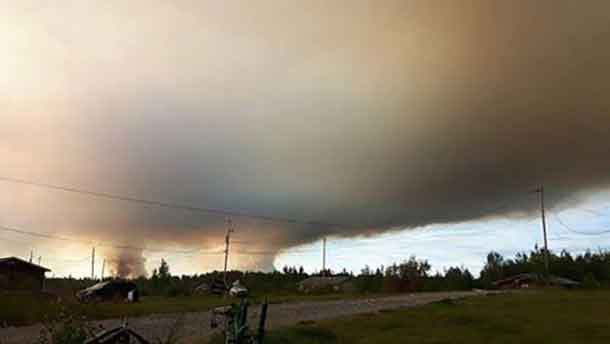
There is an Incident Management Team established in Nibinamik First Nation about 500 kilometres North of Thunder Bay to manage a complex of four fires that are to the north and northwest of the community.
Due to a power outage and smoke issues a decision was made by the community to evacuate residents to the host town of Kapuskasing. The Ministry of Natural Resources and Forestry (MNRF) coordinated commercial aircraft for the evacuation. MNRF coordinates its response with the Office of the Fire Marshall and Emergency Management via the Provincial Emergency Operations Centre which continues to work with community leaders, federal departments, non-government organizations and provincial government ministries to support the community.
Other northern First Nation communities with fire management resources on site to manage fires include Kitchenuhmaykoosib Inninuwug (KI), Deer Lake, Wunnumin Lake, Eabametoong, Neskantaga and Sandy Lake.
To track the fire hazards and to see a complete list of fires across the province click on the interactive map. You can also get the latest update on the condition of any fire by clicking the fire icons.
Currently Quebec is assisting Ontario in the Northwest Region with two CL-415 water-bombers. Minnesota has also provided a Tactical Aircraft capable of air attack or transport as required.
Out of Province Deployment
- Currently there are over 46 staff supporting the province of British Columbia in their fire management efforts.
- Ontario continues to have firefighting staff on the ground in British Columbia to help support ongoing firefighting efforts. This is being done while also ensuring we have the necessary firefighting personnel here at home.
The public are urged to take an active role in preventing more fires. This can be done by not burning when it is windy, monitoring your fire and ensuring that you have water nearby to extinguish your fire. As a reminder, there is no day burning of brush and grass.
Planning to have a campfire?
Here are some tips on how to safely enjoy your campfire and avoid the costs and dangers that can arise from an unextinguished or unattended campfire:
- Choose your site carefully. Select a site with easy access to water that is sheltered from high winds. The fire must be built on bare rock or non-combustible material.
- Prepare the site. Clear a one metre space around your campfire site and remove all pine needles, grasses, leaves and twigs.
- Keep your fire small. By law, your campfire cannot exceed one metre in height and one metre in diameter.
- Stay nearby. Never leave your campfire unattended.
- Put your fire out. Soak your fire with water.
- Be sure the fire is extinguished. Stir the ashes with a stick to uncover hot coals and then soak it again!
Ontario has increased the maximum fines for individuals and corporations for starting forest fires.
Increased Fines for Starting a Forest Fire
Fire numbers and online information:
Forest Fire Reporting Number – 310-FIRE (3473)
- Follow us on Twitter: in English @ONForestFires or in French @ONFeuDeForêt<./li>
- For guidelines on safe outdoor fire management ontario.ca/fireprevention
With files from Morgan Reill


